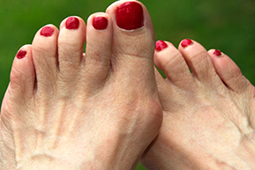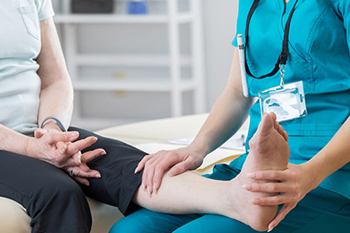Walking or simply wearing shoes can be extremely uncomfortable when you have bunions, hammertoes, and other toe and forefoot deformities. If you’re suffering pain or irritation when wearing shoes, have limited movement of the toes, redness, swelling, irritation, a lump on the toe or foot or an abnormal bend in your toe, it’s important to see a doctor. If left untreated, bunions, hammertoes, and other forefoot conditions can become progressively worse and more difficult to treat. Open sores may develop on the toe, which can lead to infection. In some cases, surgery is needed to correct the problem.
Common conditions

At MedStar Health, our podiatric surgeons have extensive experience treating conditions that affect the lower extremities. The following are a few conditions they commonly treat:
- Bunions occur when the big toe moves inward or toward the other toes, forming a painful lump at the base of the big toe.
- Tailor’s bunions (also called bunionettes) may develop as a sensitive bump on the smallest, outer toe.
- Hammertoes happen when there’s an abnormal bend in the middle joint of a toe, causing the tip of the toe to bend and face downward.
- Mallet toes affect the joint nearest the toenail, most commonly the second toe.
- Claw toes affect the four smaller toes at the same time, causing the toes to curl downward.
- Brachymetatarsia (also called short toe) occurs when there is one or more abnormally short or overlapping toe, most commonly the fourth toe.
Toe and forefoot deformities may be inherited, congenital or caused by injuries to the foot (e.g., wearing tight shoes), structural abnormalities of the foot, an imbalance of muscles in the toe or foot, or health conditions such as arthritis or diabetes.
Bunions
A bunion, also known as hallux valgus, refers to a common toe condition that is usually caused by wearing excessively tight shoes. The condition is characterized by a bony, inflamed bump that forms along the big toe. While this lump is the most noticeable symptom of a bunion, the condition is a result of a shift in the bony framework in the front of a person’s foot. It can involve one or more of the bones moving out of alignment and tends to worsen over time. Sometimes, a bunion causes only minor discomfort. In other cases, it can be incredibly painful and require surgery by an orthopedic specialist.
Bunions
Bunions are a common foot deformity that can be inherited or can occur as a result of repeated stress to the joint.
What causes a bunion?
Bunions are the result of the big toe repeatedly pushing against the neighboring toe, which causes bone instability in the front part of the foot. Over time, this causes the base of the toe joint to push outward and swell, forming the bony lump that typically characterizes a bunion. Bunions are common and are typically triggered by one of the following:
- Wearing excessively tight shoes, especially high heels
- Foot arthritis
What are the symptoms of a bunion?
If you are suffering from any of the signs of a bunion listed below, it is important to visit an orthopedic specialist at MedStar Health:
- Pain in the outer base of the big toe
- A noticeable bump along the big toe joint
- Redness around the big toe
- Burning sensation on the side of the big toe
- Inability to move the big toe
- Swelling in the big toe
- Big toe pain that worsens over time
- Big toe pain that worsens with tight shoes or high heels
How are bunions diagnosed?
Our team of physicians are experts at diagnosing a wide range of foot and ankle problems. An initial exam for bunion diagnosis generally includes:
- Medical history evaluation : Our physicians will speak with you about past relevant medical issues and ask you questions about when your bunion symptoms began.
- Physical exam :This may include asking questions about your pain level and examining the affected area.
- Imaging tests :If necessary, our physicians may use diagnostic imaging to look more closely at the affected area and to make an accurate diagnosis.
What are the best bunion treatment options?
If you are experiencing signs of a bunion, visit one of our orthopedic specialists at MedStar Health. One of our skilled doctors will thoroughly review your symptoms, medical history, and any needed diagnostic testing. When symptoms are mild, your doctor may recommend one of the following conservative options for bunion treatment without surgery:
- Ice to decrease swelling and pain
- Alternative footwear to lessen the progression of a bunion
- Bunion orthotics to relieve pressure on the big toe
- Protective padding or tape to reduce pressure
- Anti-inflammatory medications to reduce swelling
At MedStar Health, we also offer comprehensive bunion surgery, known as a bunionectomy or bunion foot surgery. During bunion foot surgery, the bunion is removed and the muscles and bones surrounding the big toe are repaired. This treatment option is usually recommended after conservative approaches are unsuccessful or when pain is severe.
Planning and recovery
What to expect
During your appointment, your doctor will first examine your feet and toes for signs and symptoms of bunions, hammertoe, or other conditions. He or she may request an X-ray image of the affected foot to uncover any abnormalities in the bone structure. Your podiatric surgeon will determine which treatment options are best for you depending on your age, the severity of symptoms, conclusions drawn from an X-ray exam, and other factors.
Nonsurgical treatment: If symptoms are mild, your doctor may recommend conservative treatment options such as wearing shoes that are looser and have a wider toe box, using orthotics or custom shoe inserts to reposition the toes and relieve pressure.
Surgical treatment: If symptoms are severe and affecting your ability to walk comfortably and correctly, your doctor may recommend surgery. A bunionectomy is a surgical procedure that may involve removing the bunion, realigning the bones that make up the big toe, or balancing the muscles and tissues around the joint so the deformity does not return. Hammertoe surgery releases the bent position of the toe, reduces pain and discomfort, and increases the overall function of the toe and foot.
Recovery after podiatric surgery

During the first few days following surgery, it’s important to keep your swelling down and minimize your pain. You will also need to keep your foot elevated and avoid walking on it. After a few weeks, you can begin bearing more weight on the affected foot. Your doctor may give you a special shoe or boot to wear to protect your toe, as well as require that you rest your foot during this time. Physical therapy may also be recommended to help you regain your strength. Your orthopedic foot and ankle surgeon will discuss the specific details of your recovery with you before your procedure.
Our providers
Location: Change location Enter your location
Foot and Ankle Orthopedic Surgery
-
Nicholas D. Casscells, MD
Foot And Ankle Orthopedic Surgery
-
Paul Stuart Cooper, MD
Foot And Ankle Orthopedic Surgery
-
Gregory Paul Guyton, MD
Foot And Ankle Orthopedic Surgery
-
Walter Chad Hembree, MD
Foot And Ankle Orthopedic Surgery
-
Stuart D. Miller, MD
Foot And Ankle Orthopedic Surgery
-
Jacob M. Wisbeck, MD
Foot And Ankle Orthopedic Surgery
Orthopedic Surgery
-
Brock William Adams, MD
Orthopedic Surgery & Orthopedic Oncology
-
Farhang Alaee, MD
Orthopedic Surgery
-
Dennis Carlini, MD
Orthopedic Surgery
-
Allison Liefeld Fillar, MD
Sports Medicine, Orthopedic Sports Medicine & Orthopedic Surgery
-
David Larry Gold, MD
Orthopedic Surgery
-
Daniel Mark Hampton, MD
Sports Medicine, Ankle Orthopedic Surgery, Shoulder Orthopedic Surgery, Orthopedic Surgery, Knee Orthopedic Surgery, Hip And Knee Orthopedic Surgery, Hip Orthopedic Surgery & Orthopedic Sports Medicine
-
Jessica B Hawken, MD
Orthopedic Surgery
-
Bruce Knolmayer, MBBS
Orthopedic Surgery
-
Thomas Milleret Ring, MD
Orthopedic Surgery
-
Jeffrey D. Sabloff, MD
Orthopedic Surgery
-
Ira Dean Gelb, MD
Orthopedic Surgery
-
Sanjog K. Mathur, MBBS
Orthopedic Surgery
-
Charles Francis Mess, MD
Orthopedic Surgery
-
Charles Francis Mess, Jr., MD
Orthopedic Surgery
-
Megan Rose Miles, MD
Orthopedic Surgery
-
Mark Donald Perry, MD
Orthopedic Surgery
-
Patricia Turner, MD
Orthopedic Surgery
-
William Robert Volk, MD
Orthopedic Surgery
Frequently asked questions
-
Can choosing the right footwear prevent foot pain?
Yes, finding a shoe that fits properly can save your feet from painful problems later on. Wearing shoes that are too tight can cause painful ailments such as bunions, hammertoes, corns and other foot problems. Instead, choose footwear that fits well and allows ample room at the toe. -
Is podiatric surgery covered by insurance?
Your procedure may be covered by insurance if it is deemed medically necessary. Please contact your insurance company to determine your coverage. -
How should I prepare for surgery?
Before surgery, you may be asked to get blood tests and take or adjust medications. If you smoke, quitting will help you heal faster and better avoid complications. Your surgeon may even require that you quit smoking prior to surgery. You’ll be given special instructions to follow prior to your surgery.
-
How long does it take to recover from podiatric surgery?
Recovery time depends on the type of surgery and level of correction needed, and it may take a few weeks or a number of months. Your surgeon will discuss a realistic time frame for your recovery.
-
Will I need physical therapy?
Your doctor may recommend a physical therapy program to help you get the best results from your surgery. Physical therapy can help you regain range of motion, strength and flexibility after surgery.









